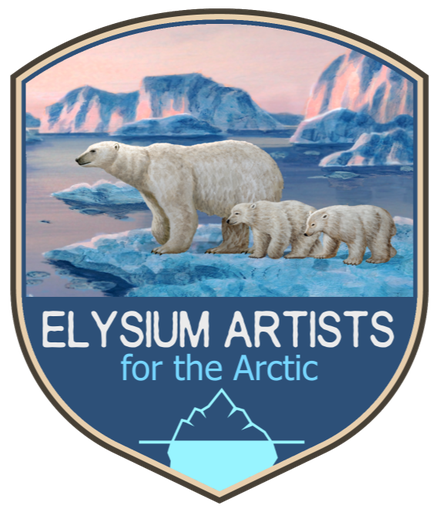Navigate:VIRTUAL EXPLORATIONS > ARCHIVED EXPLORATIONS > ELYSIUM ARTISTS FOR THE ARCTIC
|
Part 7: About Those Bears...Posted: Thursday, September 3, 2015
Polar bears, Ursus maritimus, are uniquely adapted to life on the ice. Their white, water-repellant fur camouflages them against a snowy backdrop making it easier for them to hunt, while they have a thick layer of subcutaneous fat that helps insulate them against the frigid waters and the bitter cold of arctic winters. Their particularly large size actually reduces the overall surface area to body mass ratio, effectively minimizing exposure to the elements and consequently minimizing energy loss. These huge carnivores can weigh up to 1,697 lbs (770 kg) in the case of adult males, while large females don’t get much bigger than 992 lbs (450 kg). The typical diet of a polar bear consists almost exclusively of ringed and bearded seals, supplemented by the occasional walrus, beluga whale, and other seal species. This is where loss of arctic sea ice poses the greatest threat. The Arctic region is warming faster than anywhere else in the world, and the animals that live there have little choice but to adapt or perish. Due to the increasingly ice free summers, polar bears are losing the seals that are their main source of food. Polar bears hunt seals from the ice, and with sea ice cover at record lows, the bears are being forced to turn to alternative prey items on land. They expend too much energy trying to capture seals in the water, so they have begun eating huge quantities of bird eggs in an effort to supplement their diets enough to survive the warming Arctic summer until the ice returns in winter. This has had a devastating impact on the populations of certain species of Arctic birds, most notably the common eider (Somateria mollissima), a ground-nesting duck, and the thick-billed murre (Uria lomvia), a cliff-nesting bird, whose colonies are declining rapidly in close association with shrinking summer sea ice.
This is just one of the many changes occurring in our polar north that has been set in motion by our warming climate. |
|
About Oceanscape
The Oregon Coast Aquarium's Oceanscape Network is an educational program for youth designed to inspire curiosity in science, nature, conservation and outdoor exploration while providing valuable classroom resources for educators. MORE.
Quick Links
|
Finding the Aquarium
Oceanscape Network © 2023 by the Oregon Coast Aquarium. All rights reserved.
|












